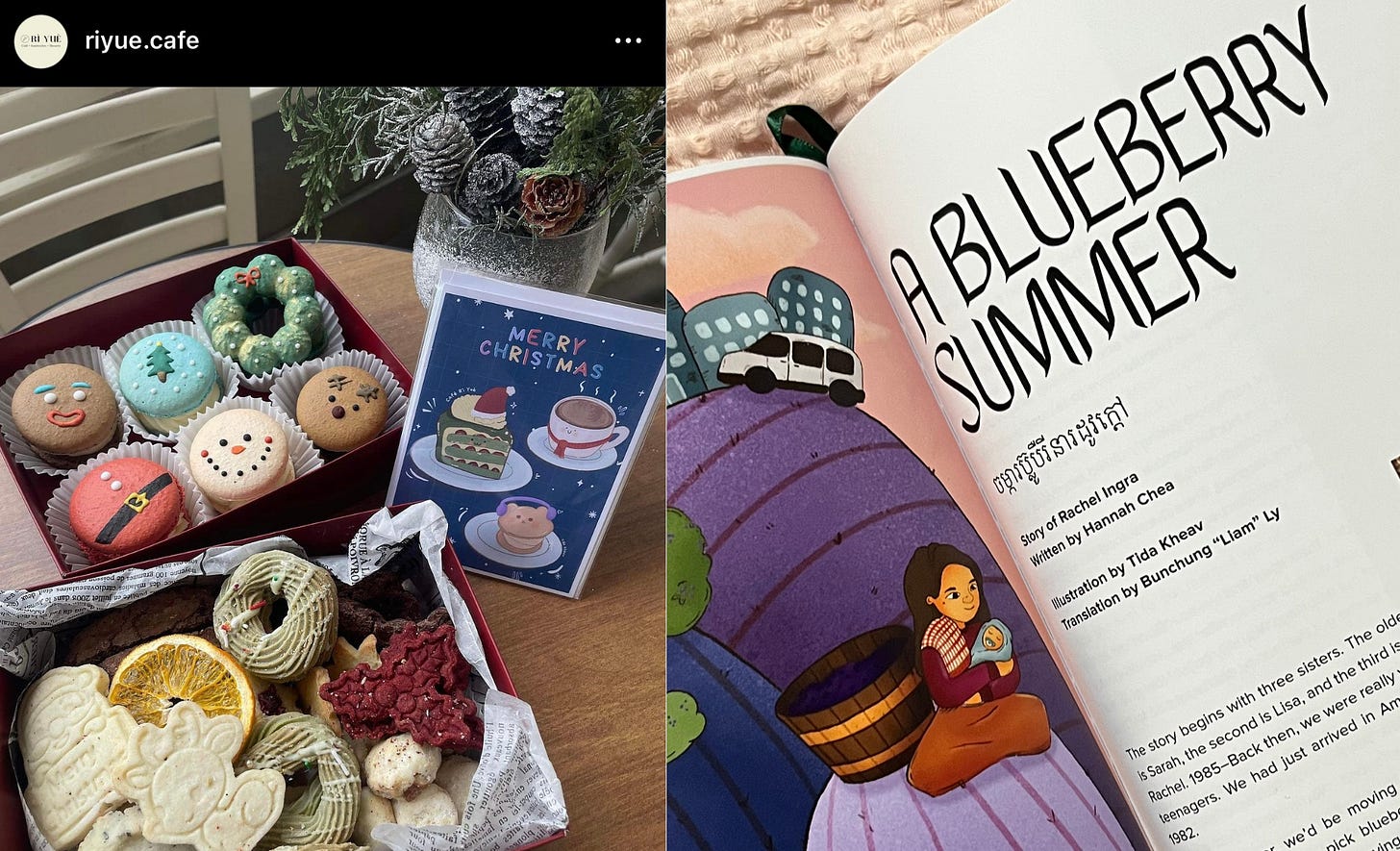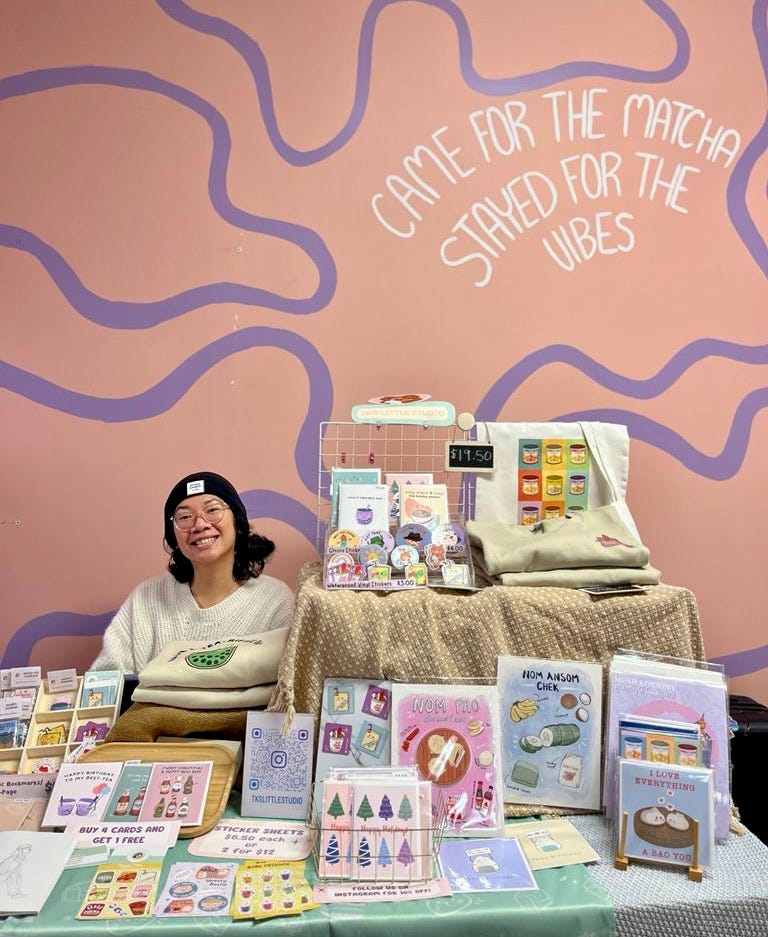5 Valuable Lessons from My First 5 Months as an Illustrator
My chaotic yet incredible first five months of business.
December marks five whole months of being in business as a part-time illustrator and small business owner. Wild, right? I can’t believe it either. There were many mistakes made, but that just means many lessons learned. My first five months included some amazing opportunities.
My illustration-based products can be found at Shop Wolf & Rebel (a Windsor-based stationery shop), Rì Yuè Café (a bakery café in Montreal), and of course, in my online shop. I have attended 13 markets across Montréal within those five months. The highlight of my year was having my one-page illustration published in The SEAD Project’s book, “Knowing Our Joy” alongside some incredibly talented Khmer writers and illustrators. It’s been a busy five months, and I’m still figuring things out, but I wanted to share the five main lessons I learned.
5. If You Never Ask, The Answer Is Always No
Pushing myself out of my comfort zone was a priority for me this year. I was an extremely shy child growing up—think refusing to order pizza over the phone kind of shy. Thankfully, I've outgrown it, but not entirely. While I can now confidently order pizza over the phone (a big accomplishment, I know), I still struggle a bit when it comes to striking up conversations with new people.
There is tons of value in asking for the things you want or are curious to know. Do you want your products in someone’s shop? Ask. Interested in collaborating with an artist you've been admiring? Ask. Eager to learn more about how another artist does what they do? Ask.
The worst-case scenario? You get rejected.
The best-case scenario? You get a yes.
Rejection is merely redirection. It's a chance to refine and improve to eventually get a yes.
In a previous post, I mentioned how I successfully got my products stocked at a local Windsor shop. All it took was for me to ask if the shop was open to accepting new items for stock. You can read more about how I received my first wholesale order here.
4. Research Your Suppliers And Markets
I am in the process of acquiring the necessary equipment for my home studio: a sublimation printer, Silhouette Cameo, screenprinting materials—the list goes on. These purchases add up quickly, so in the initial stages of production, there is no shame in outsourcing your work to either local or international manufacturers. If you choose to outsource the printing or manufacturing of your products, thorough research is essential. Support local print shops if possible and shop around for the best prices and quality.
Once you have your products printed and ready to go, what's next? Look for local markets to sign up as a vendor. Choosing the right markets is as crucial as the production process. Consider the following questions:
What types of vendors are accepted into the market?
Does the organizer of the market have statistics available, such as the number of patrons for each event?
Is the event well-advertised?
Is the table fee affordable, or is it worth paying for in comparison to the items you sell?
Have you heard positive feedback about the event organizer?
The answers to these questions can truly make or break your market experience. I've attended markets with low table fees and a great turnout—both in terms of the number of attendees, vendors making sales, and overall positive vibes. However, I've also been to higher-end markets with much more expensive table fees, low sales, and patrons who were more interested in the event itself than the vendors. Before applying, check out the markets on social media. Are patrons there to shop and support local artists, or are they attending for the photo-op because it looks like a cute and trendy event? Once again, don't hesitate to ask previous vendors about their experiences at markets you're interested in.
3. Have A Strong Online Presence
Social media—a necessary evil for your small business. The constant demand for consistent posts and the perpetual adjustments to algorithms can be downright exhausting. Filming, photographing, editing, and conjuring up text descriptions or captions—it's a whole production. Most artists, myself included, dive into creating without sparing much thought for documenting the process. After all, we're artists, not social media managers. Yet, as a small business owner, you become a pro at wearing multiple hats and begin mastering the art of self-marketing.
Sharing your work doesn’t equate to creating a fresh masterpiece every single day—that’s a fast track to burnout town. Instead, it could mean sharing snippets of your process, the materials you like using, and posts that show your failures and successes.
I've tested different post types—time-lapse drawings, drawing challenges, and sketches. However, I've noticed a spike in interest and engagement for posts that show my process and offer snapshots of my life—simply put, posts about me, the artist.
It shows social media users that there’s a real human behind all of these posts. It's about building a connection with your community. Authenticity and realness are the magic ingredients. So, just be yourself and give people a glimpse of the person behind the art.
2. Make Plans
Get your journals, planners, or whatever digital calendar you prefer to use because we will need a snapshot of the upcoming months. Planning helps you organize your time a hell of a lot better. Make a list of upcoming markets and project deadlines. Markdown plans to create any seasonal-related products and provide enough time for print, manufacturing, and additional prep work needed.
Got a list of markets you’ve been wanting to attend? Add it to your calendar accordingly. Want to prioritize growing your following? Figure out a content schedule.
It may sound simple but it’s the little things that sneak up on you. And as with most artists, or, at least within my artist friend groups, we may not be the best at planning and organizing. We have our own chaotic ways that manage to work in the end, but there is a better way to prevent that last-minute chaotic stress.
Last year, I did not plan well enough when it was time to launch holiday products online. While they did well at in-person markets, online sales for holiday-related items did just okay. I did not set enough time to create, print, update the listings online, advertise, and factor in shipping times on top of it all.
It’s easier said than done, but make a plan, organize your shit, and do your best to stick with it.
1. Find Your People
Finally, connect with other artists and your followers! Once you figure out what type of artwork you like producing, and which communities and groups of people you relate to, it becomes a lot easier to grow a following. Not only does your work begin to reach the “right” target audience, but it also helps you see that your work is meaningful to others too. It makes connecting with others that much more genuine and enjoyable. You don’t need to stick to connecting with one community either. That’s the beauty of art — it’s appreciated by all kinds of folks.
This brings us back to having a strong online presence — by being yourself, sharing your values, the artwork you like, and things that others can connect with, it opens the door for conversations. By sharing through Instagram stories and descriptive personalized captions for my posts, I’ve been able to build friendships with local artists in the city and even abroad. I adore the way my new artist friends support and uplift one another.
By sharing my heritage and creating work related to my culture, I was also able to become friends with fellow Cambodian artists. Connecting with Cambodian artists last year has probably been one of the best parts of my illustration journey. Something about it hits different, and in the best way. I can’t wait to meet more like-minded artists and continue to nurture these new friendships.

While 2023 brought its fair share of challenges, marked by losses and global sadness, I'm finding ways to appreciate what I've gained. It can be tough at times, but for me, it's helpful to remember that I'm still here and have the ability to do something meaningful that might make a positive impact in the world.
With the new year here, I can't wait for all the new lessons I'll learn and the friendships I'll create. Something I'd like to focus on this year is using my art to connect with my culture and people. I want to create art that can voice my beliefs and values; something impactful and worthwhile.








